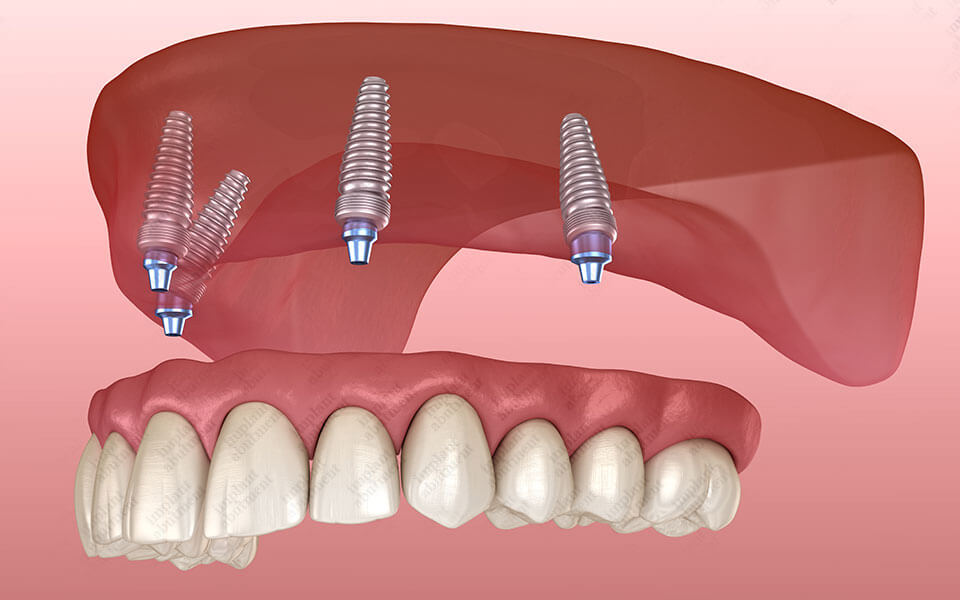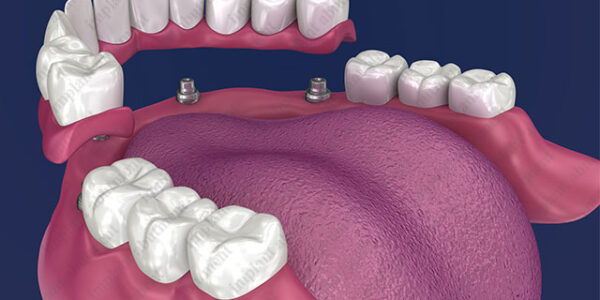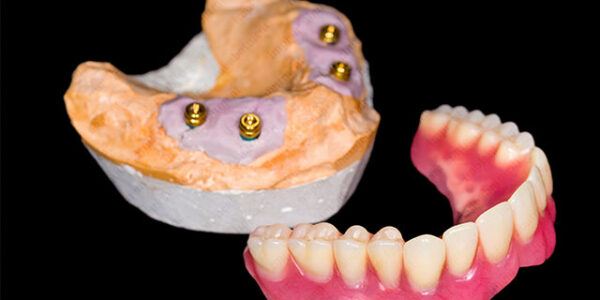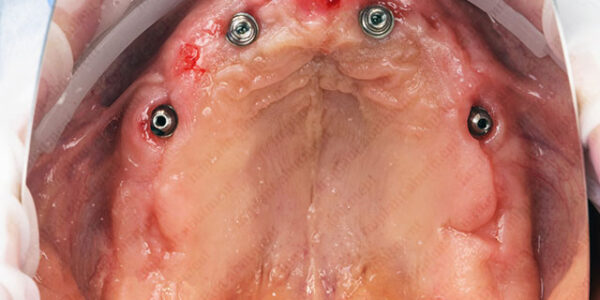What are All-on-4 implants?
Full arch restorations, which involve the replacement of an entire dental arch’s teeth, can be achieved using one of several solutions. It is the implant-supported overdenture, however, that is the most stable and successful option. The term ‘All-on-4’ simply refers to an implant-supported restoration that is supported by four implants. The same concept exists for six and eight implants, respectively called — you guessed it — All-on-6 and All-on-8. It is common for All-on-4 restorations to be used on the lower arch, All-on-8 restorations to be used on the lower arch, while All-on-6 restorations are used frequently for both arches.
Implant-supported overdentures consist of either a permanent or semi-permanent prosthesis which is placed over a series of implants that are embedded into the jawbone and serve as an anchor for the prosthesis. The All-on-4 restoration is an alternative to classic removable dentures and bridges, as well as to an arch-full of individual implants for each tooth. The advantages of the All-on-4 over these alternatives are numerous, but most importantly this type of restoration features higher stability and efficiency than other restorations, and is more natural-looking and functional than the other options. It is also the healthiest solution regarding oral bone health, providing stimulation to the jaw bone, which in turn prevents bone atrophy and subsequent facial collapse.
How to clean All-on-4 implants: The 5 must-do’s
A regular oral hygiene routine is a must, no matter what, and it is important to know how having a full arch restoration changes that routine’s requirements. In addition to the classic brushing and flossing routine paired with regular office visits that our dentists so often prescribe, it is encouraged that All-on-4 patients include a Waterpik and rinsing into their daily routines. Here is a more in-depth look at each of these necessary elements of how to clean All-on-4 implants and general proper care.
5 Must-Do’s to Make Your Restoration Last a Lifetime
1. Brushing
Just as with your original teeth, All-on-4 implants require daily brushing. Similar to regular brushing, your prosthesis should be brushed for at least two minutes, twice a day, with a soft-bristled or electric toothbrush; this part can be done together with the rest of your teeth. Prosthesis brushing has some additional requirements, however, which make its care slightly more specialized than normal brushing.
After normal daily brushing, a sulcus brush should then be used to clean along and below the gum line. Sulcus brushes are about a third of the size of a normal toothbrush. They are specifically designed for cleaning and removing plaque from the gingival sulcus, which is especially important for All-on-4 patients, as this is the point where the prosthesis transitions to the soft gum tissue. The sulcus brush can also be used to massage these transition areas, stimulating blood flow and encouraging gum health.
Other brushes that are specifically designed for implants may be recommended by your dentist. Angled head brushes give better access to more difficult-to-reach areas leading to implant-abutment surfaces, such as palatal and lingual sites, and especially those that are located farther back in the mouth.
Gentle interdental brushes are another type of brush that are rapidly increasing in popularity, even for non-edentulous patients. These brushes can be used daily, with a simple, single insertion and removal between each interdental space to remove any plaque or debris.
2. Flossing
Flossing is a crucial component of every dental hygiene routine, as it cleans the hard-to-reach spaces between your teeth. Left unattended, these spaces can become a harbor for bacteria that can ultimately lead to infection or tooth decay. That said, there is debate about using floss with dental implants, because improper use can sever gingiva-abutment attachments and lead to peri-implantitis. However, floss can help to remove food particles, debris and plaque from under the bridge and around the implants. If your treating dental professional agrees, floss can be used daily to clean these areas. Using super floss is advisable, as it features a threading mechanism at each end and is thicker and more durable than other flosses, making it ideal for use with dental prostheses.
3. Waterpik use
Also considered a more gentle approach to the removal of debris from interdental spaces and around the prosthesis, the Waterpik can be used twice a day. Special care should be paid to the areas where food can easily become lodged, especially along the gumline where the prosthesis and soft tissue meet. The low or medium setting is adequate and recommended to perform this cleaning. The high setting can be overly aggressive and cause tissue damage to the gums.
4. Daily rinsing
Daily use of mouthwash can help to remove debris trapped around the prosthesis, as well as to keep bacterial populations under control. Mouthwashes should be used with care, as they may contain aggressive ingredients that can cause harm to the gingiva. Treating dentists should be consulted to find out what type of mouthwash is appropriate for each individual patient. Some dental professionals will recommend an alcohol-free mouthwash, or a dilution in water.
5. Regular dental visits
Last but not least is the extremely important dental visit. Keeping up with your oral hygiene involves regular visits to the dentist, not only to get a more thorough and deeper clean, but also so that the dentist can keep track of your restoration and catch any problems early on. Regular visits every six months are advised for healthy patients, while those with complications are recommended to go more often. If any issues arise with a restoration, a dental professional should be contacted immediately.
Cleaning All-on-4 implants: It’s a matter of health
Dental restorations require as much attention and care as regular teeth. Keeping a healthy mouth is the best way to prevent any unwanted complications, not only with the restoration itself, but also with health issues such as gum infection, periodontal disease and heart disease. Investing in a proper oral hygiene regimen means investing in your overall, long-term health.





